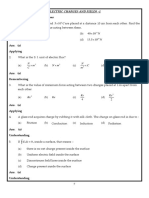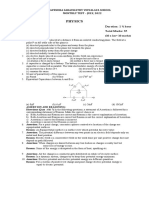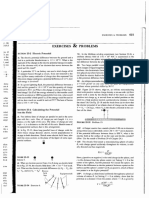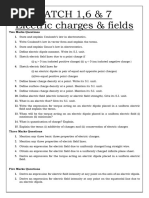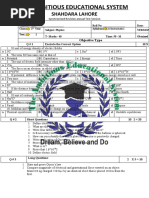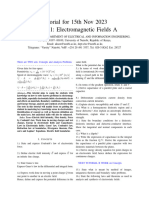12 Physics Electricchargesfield Tp04
12 Physics Electricchargesfield Tp04
Uploaded by
AVNEESH CHAUBEYCopyright:
Available Formats
12 Physics Electricchargesfield Tp04
12 Physics Electricchargesfield Tp04
Uploaded by
AVNEESH CHAUBEYCopyright
Available Formats
Share this document
Did you find this document useful?
Is this content inappropriate?
Copyright:
Available Formats
12 Physics Electricchargesfield Tp04
12 Physics Electricchargesfield Tp04
Uploaded by
AVNEESH CHAUBEYCopyright:
Available Formats
myCBSEguide
Class 12 - Physics
Electric Charges and Fields Test 04
Question No. 1 to 5 are based on the given text. Read the text carefully and answer the questions:
dq
Surface charge density is defined as charge per unit surface area of surface charge distribution. i.e., σ = dS
. Two large, thin
metal plates are parallel and close to each other. On their inner faces, the plates have surface charge densities of opposite signs
having magnitude of 17.0 × 10-22 Cm-2 as shown. The intensity of electric field at a point is E = σ
ε0
, where ε = permittivity of
0
free space.
1. E in the outer region of the first plate is
a. 1.5 × 10-25 N/C
b. 1.9 × 10-10 N/C
c. 17 × 10-22 N/C
d. zero
2. E in the outer region of the second plate is
a. zero
b. 1.9 × 10-10 N/C
c. 17 × 10-22 N/C
d. 1.5 × 10-15 N/C
To practice more questions & prepare well for exams, download myCBSEguide App. It provides complete study
material for CBSE, NCERT, JEE (main), NEET-UG and NDA exams. Teachers can use Examin8 App to create similar
papers with their own name and logo.
3. E between the plates is
a. 1.9 × 10-10 N/C
b. 1.5 × 10-15 N/C
c. zero
d. 17 × 10-22 N/C
4. The ratio of E from right side of B at distances 2 cm and 4 cm, respectively is
a. 1 : 2
–
b. 1 : √2
c. 2 : 1
d. 1 : 1
5. In order to estimate the electric field due to a thin finite plane metal plate, the Gaussian surface considered is
a. cylindrical
b. none of these
c. spherical
d. straight line
Copyright © myCBSEguide.com. Mass distribution in any mode is strictly prohibited.
1/6
myCBSEguide
6. A ring of charge with radius 0.5 m having a 0.02 m gap, carries a charge of +1 C. The field at the centre is:
a. 2.31 × 104 N/C
b. 1.6 × 104 N/C
c. 2.31 × 108 N/C
d. 1.6 × 108 N/C
7. A stationary charge produces:
a. electric field and magnetic field both
b. none of these
c. a magnetic field only
d. an electric field only
8. Assertion (A): If there exists a coulomb attraction between two bodies, both of them may not be charged.
Reason (R): In coulomb attraction, two bodies are oppositely charged.
a. Both A and R are true and R is the correct explanation of A.
b. Both A and R are true but R is not the correct explanation of A.
c. A is true but R is false.
d. A is false but R is true.
9. Assertion (A): A point charge is lying at the center of a cube of each side l. The electric flux emanating from each
surface of the cube is ( )th of total flux.
Reason (R): According to Gauss’ theorem, total electric flux through a closed surface enclosing a charge is equal to (
1
) times the magnitude of the charge enclosed.
∈0
a. Both A and R are true and R is the correct explanation of A.
b. Both A and R are true but R is not the correct explanation of A.
c. A is true but R is false.
d. A is false but R is true.
10. State True or False:
i. Electric lines of force form closed loops.
a. True
b. False
ii. For a point charge, the electrostatic field varies as .
1
2
r
a. True
b. False
11. Fill in the blanks:
a. The ratio of the permittivity of the given medium to that of free space is known as ________.
ε
ε0
b. Electric lines of force are always ________ to the surface of a conductor.
To practice more questions & prepare well for exams, download myCBSEguide App. It provides complete study
material for CBSE, NCERT, JEE (main), NEET-UG and NDA exams. Teachers can use Examin8 App to create similar
papers with their own name and logo.
12. Match the following:
(a) absolute permittivity of the medium (i) no units
(b) relative permittivity of the medium (ii) C2N-1m-2
Copyright © myCBSEguide.com. Mass distribution in any mode is strictly prohibited.
2/6
myCBSEguide
(c) electric dipole moment (iii) C/m
(d) linear charge density (iv) Cm
13. A box encloses an electrical dipole consisting of charge 5μ C and - 5μ C and of length 10 cm. What is the total electric
flux through the box?
14. Dielectric constant of a medium is unity. What will be its permittivity?
15. Eight identical point charges of q coulomb each are placed at the corners of a cube of each side 0.1 m. Calculate the
electric field at the centre G of the cube. Calculate the field at the centre when one of the corner charges is removed.
16. The figure shows three different patterns of electric field lines. In each pattern, a proton is released from rest at point P
and then accelerated towards the point Q by the electric field. Rank the patterns according to the linear momentum of the
proton when it reaches Q greatest first.
17. An electric dipole consists of two opposite charges each of magnitude 1 μ C separated by 2 cm. The dipole is placed in
an external electric field of 105NC-1. Find
i. the maximum torque exerted by the field on the dipole
ii. the work which the external agent will have to do in turning the dipole through 180° starting from the position 0 = 0°
18. a. Show that in a uniform electric field, a dipole experiences only a torque but no net force. Derive expression for the
torque.
b. An electric dipole consists of two equal and opposite charges placed 2cm apart. When the dipole is placed in a
uniform electric field of strength 105 NC-1, it experiences a maximum torque of 0.2× 10-3 Nm. Find the magnitude
of each charge.
Copyright © myCBSEguide.com. Mass distribution in any mode is strictly prohibited.
3/6
myCBSEguide
Class 12 - Physics
Electric Charges and Fields Test 04
Solution
1. (d) zero
Explanation: There are two plates A and B having surface charge densities, σ = 17.0 × 10 C/m2 on B, A
−22
respectively. According to Gauss' theorem, if the plates have same surface charge density but having opposite signs, then
the electric field in region I is zero.
EI = EA + EB = = 0
σ σ
+ (− )
2ε0 2ε0
2. (a) zero
Explanation: The electric field in region III is also zero.
EIII = EA + EB = 2ε0
σ
+ (−
2ε0
σ
) = 0
To practice more questions & prepare well for exams, download myCBSEguide App. It provides complete study
material for CBSE, NCERT, JEE (main), NEET-UG and NDA exams. Teachers can use Examin8 App to create similar
papers with their own name and logo.
3. (a) 1.9 × 10-10 N/C
Explanation: In region II or between the plates, the electric field.
EII = EA - EB = +
2ε0
σ σ
2ε0
σ(σA or σB ) −22
= ε0
=
17.0×10
−12
8.85×10
E = 1.9 × 10-10 NC-1
4. (d) 1 : 1
Explanation: Since, electric field due to an infinite-plane sheet of charge does not depend on the distance of observation
point from the plane sheet of charge. So, for the given distances, the ratio of E will be 1 : 1.
5. (a) cylindrical
Explanation: In order to estimate the electric field due to a thin finite plane metal plate, we take a cylindrical cross-
sectional area A and length 2r as the gaussian surface.
6. (c) 2.31 × 108 N/C
Explanation: A ring of charge = 0.5m has 0.02m
q = +1e
The electric field at the centre = Let us suppose the ring is complete, then, the complete ring has a large. 1c along with a
negative charge of
= 2.31 × 108 N/C
Kq q × 10 × 1
So, 2
=
0.25
r
7. (d) an electric field only
Explanation: an electric field only
8. (b) Both A and R are true but R is not the correct explanation of A.
Explanation: Coulomb attraction exists even when one body is charged and the other is uncharged.
9. (b) Both A and R are true but R is not the correct explanation of A.
Explanation: The electric flux through the cube,
ϕ=q
ε0
q
A cube has six face equal area, therefore electric flux through each face = = 1
6
⋅ϕ =
1
6
(
ε0
)
= × total flux.
1
10. State True or False:
Copyright © myCBSEguide.com. Mass distribution in any mode is strictly prohibited.
4/6
myCBSEguide
i. (b) False
Explanation: False
ii. (a) True
Explanation: True
11. Fill in the blanks:
a. Relative permittivity
b. Normal
12. (a) - (ii), (b) - (i), (c) - (iv), (d) - (iii)
13. Since net charge enclosed by the box is zero, electric flux through the box is also zero.
14. We know that dielectric constant of a medium is
∈
k = ∈ = r
∈0
∴∈= k ∈0 = 1 × 8.854 × 10
−12
−12 2 −1 −2
= 8.854 × 10 C N m
15. Length of each side, l = 0.1 m
Distance of each corner from the centre of the cube is
10-2 m
√3l √3×0.1 –
r = 2
=
2
= 5√3×
When all the eight-point charges are placed at the corners, electric fields of the diagonally opposite charges cancel out in
pairs.
∴ Net field at the centre = 0
When a charge is removed from one corner, the electric fields due to three pairs of charges cancel out. However, the
charge at the remaining corner creates field,
= 1.2 × 1012 q NC-1
q×1 9×10 ×q
E = 4πε0
1
⋅
r
2
=
−2
2
(5√3×10 )
The field points towards the corner having no charge.
16. The lines of force near point P are closest to each other in a pattern (c) and farthest apart in a pattern (a). Consequently,
the electric field near point P is strongest in case (c) and weakest in case (a).
∴ The momentum of the proton at point Q in a pattern (c) > Momentum of a proton at point Q in a pattern (b) >
Momentum of the proton at point Q in a pattern (a).
17. p = q × 2a = 10-6 × 0.02 = 2 × 10-8 cm
i. tmax = pE sin 90° = 2 × 10-8 × 105 × 1
= 2 × 10-3 Nm.
ii. W = pE(cos θ - cos θ )
1 2
10-8 × 105 (cos 0 - cos 180 )
∘ ∘
=2×
= 2 × 10-3( 1 + 1) = 4 × 10-3 J.
To practice more questions & prepare well for exams, download myCBSEguide App. It provides complete study
material for CBSE, NCERT, JEE (main), NEET-UG and NDA exams. Teachers can use Examin8 App to create similar
papers with their own name and logo.
18. a. Consider an electric dipole consisting of charges - q and +q and of length 2a placed in a uniform electric field
→
E making an angle θ with the direction of the field as shown in Fig.
Copyright © myCBSEguide.com. Mass distribution in any mode is strictly prohibited.
5/6
myCBSEguide
→ →
Force on charge -q at A = -q E (opposite to E )
→ →
and force on charge +q at B = q E (along E )
Thus, electric dipole is under the action of two equal and unlike parallel forces, which give rise to a torque on the
dipole. The magnitude of the torque is given by
τ = either force × perpendicular distance between the two forces
= q E (AN) = q E (2a sin θ ) = q (2a) E sin θ
or τ = p E sin θ ....(i)
Here, p = q (2a) is electric dipole moment of the electric dipole.
The torque on the dipole tends to align it along the direction of the electric field.
→
Since electric dipole moment vector p is a vector from the charge - q to + q, the equation (i) may be expressed as
⃗
τ ⃗ = p ⃗ × E
b. Here, 2a = 2 cm = 0⋅ 02 m, τ max = 0⋅ 2 × 10-3 Nm and E = 105 NC-1
Now, maximum torque on the dipole,
τ max = pE = q (2a) × E
−3
τmax 0.2×10 −7
∴ q = = = 10 C
5
(2a)E 0.02×10
Copyright © myCBSEguide.com. Mass distribution in any mode is strictly prohibited.
6/6
You might also like
- BEST Mult Choice ReviewDocument5 pagesBEST Mult Choice ReviewTariq ZaitounNo ratings yet
- 12 Physics Electricchargesfield Tp01Document7 pages12 Physics Electricchargesfield Tp01Aryan KulratanNo ratings yet
- Chap 01-02Document3 pagesChap 01-02Ashesh DasNo ratings yet
- 12 - Phy - Electric Chargest Field - Question With SolutionDocument7 pages12 - Phy - Electric Chargest Field - Question With Solutionjayamadhavan2007No ratings yet
- EPC_2A_241119_050734 (1)Document8 pagesEPC_2A_241119_050734 (1)devanandars2007No ratings yet
- 12 Physics Electrostaticpotentialandcapacitance tp02Document6 pages12 Physics Electrostaticpotentialandcapacitance tp02Lakshit ManchandaNo ratings yet
- 1-Charge and FieldDocument7 pages1-Charge and FieldalltimebaksodsNo ratings yet
- Sample Paper Physics Grade 12Document7 pagesSample Paper Physics Grade 12chandram654321No ratings yet
- Assignment - 123 PDFDocument9 pagesAssignment - 123 PDFarun sharmaNo ratings yet
- Test -1 @ Unit 1 and 2Document3 pagesTest -1 @ Unit 1 and 2mgopalakrishnan936No ratings yet
- 1.electric Charge & Fields - TestDocument18 pages1.electric Charge & Fields - TestArshdeep singhNo ratings yet
- Physics Xii_mcq All ChpDocument134 pagesPhysics Xii_mcq All Chpbravojosh007No ratings yet
- Ans. (A) Applying: Electric Charges and Fields - 1 (I) Multiple Choice QuestionsDocument12 pagesAns. (A) Applying: Electric Charges and Fields - 1 (I) Multiple Choice Questionspaige100% (1)
- Physics OTQ (Best)Document138 pagesPhysics OTQ (Best)Vaibhav JoshiNo ratings yet
- preboard 2Document7 pagespreboard 2YakshdeepNo ratings yet
- XII Monthly Test QPDocument3 pagesXII Monthly Test QPermaharajanNo ratings yet
- Test 13 CH 1,2 and 3Document8 pagesTest 13 CH 1,2 and 3yajatmlk1619No ratings yet
- Class 12-JMDocument18 pagesClass 12-JMrahulkumar88rahiNo ratings yet
- Unit 112 BDocument4 pagesUnit 112 BThe FighterNo ratings yet
- Chapter 1Document15 pagesChapter 1jkfreefire07No ratings yet
- Wa0021.Document93 pagesWa0021.prajanshanmugam1234No ratings yet
- Physics Term 1Document48 pagesPhysics Term 1harsh dugharNo ratings yet
- FT Gr-12 SET ADocument8 pagesFT Gr-12 SET ARAIRSNo ratings yet
- 12 Chapter Physics 12th-1Document2 pages12 Chapter Physics 12th-1Faiza FaizaNo ratings yet
- Chap 12 Practics Paper - NEWDocument4 pagesChap 12 Practics Paper - NEWayesha nazNo ratings yet
- V R/ Rru": Exercises ProblemsDocument6 pagesV R/ Rru": Exercises ProblemsBárbara MourãoNo ratings yet
- Physics - XII (Holiday Home Work)Document10 pagesPhysics - XII (Holiday Home Work)VIVAAS .SNo ratings yet
- CH2 Electric Potential and Capacitance 2019Document6 pagesCH2 Electric Potential and Capacitance 2019PrachiNo ratings yet
- Electroststics Test PaperDocument4 pagesElectroststics Test PaperJai PrakashNo ratings yet
- AISSCE ASGNMT2class 12 Chapter 2Document4 pagesAISSCE ASGNMT2class 12 Chapter 2Sajid Khan100% (1)
- Electrostatics Revision 1Document11 pagesElectrostatics Revision 1S KNo ratings yet
- Xii Physics Excellent Series 23-24Document154 pagesXii Physics Excellent Series 23-24hudz.aboo2007No ratings yet
- Worksheet Electrostatics Chapter 1Document6 pagesWorksheet Electrostatics Chapter 1sounavakaran42No ratings yet
- XII PHYSICS EXCELLENT SERIES 23-24Document199 pagesXII PHYSICS EXCELLENT SERIES 23-24sahaana.23.kNo ratings yet
- BATCH 1,6 & 7 RT 1Document8 pagesBATCH 1,6 & 7 RT 1abhishekraibagi69No ratings yet
- Physics XII PT 1 2024-25Document6 pagesPhysics XII PT 1 2024-25duvvimanikanthNo ratings yet
- STEP Physics Ch#12 (A)Document10 pagesSTEP Physics Ch#12 (A)longliveimcbg104No ratings yet
- Xii Physics June Set 2Document4 pagesXii Physics June Set 2shreyasinghchampNo ratings yet
- ElectrostaticDocument25 pagesElectrostaticmauryalucky61No ratings yet
- electric fields and charges revision work sheet 14.05.2024Document7 pageselectric fields and charges revision work sheet 14.05.2024Apoorba ChatterjeeNo ratings yet
- Class 12 Half YearlyDocument10 pagesClass 12 Half YearlyAnkit NehraNo ratings yet
- II PUC Physics-QB-24-25-1 (1)Document22 pagesII PUC Physics-QB-24-25-1 (1)v.vizzy008No ratings yet
- Revision 8Document8 pagesRevision 8ritammandal.2008No ratings yet
- 6185-Revision Test 1 Class XII Physics Dec 16Document5 pages6185-Revision Test 1 Class XII Physics Dec 16Rehan AhmadNo ratings yet
- CBSE NCERT Solutions For Class 12 Physics Chapter 1: Back of Chapter Questions 1Document27 pagesCBSE NCERT Solutions For Class 12 Physics Chapter 1: Back of Chapter Questions 1Bikash DeyNo ratings yet
- 12 Physics Electromagneticinduction tp01Document7 pages12 Physics Electromagneticinduction tp01vinaykumarnandanNo ratings yet
- Physics ALp Inter 2Document11 pagesPhysics ALp Inter 2Kamran HafeezNo ratings yet
- Chapter 2 - Part 2 - Gauss Law, Divergence and Curl of E - PHYS 331Document55 pagesChapter 2 - Part 2 - Gauss Law, Divergence and Curl of E - PHYS 331Taukeer KhanNo ratings yet
- Ch22 h1 SolutionsDocument7 pagesCh22 h1 Solutionsld393563No ratings yet
- Electrostatics One SHOT JEE 2024Document121 pagesElectrostatics One SHOT JEE 2024arijic284No ratings yet
- Main Tutorial EMF A Nov 2024Document3 pagesMain Tutorial EMF A Nov 2024111markwaweruNo ratings yet
- 1.electric Charges and Fields-TestDocument1 page1.electric Charges and Fields-TestArshdeep singhNo ratings yet
- Free Test Series Class 12th PhysicsDocument2 pagesFree Test Series Class 12th PhysicsbellsinstitutecheemaNo ratings yet
- Rakhi Mishra 1 149457Document10 pagesRakhi Mishra 1 149457bharathsnair795No ratings yet
- Chapter 2 Electrostatic Potential and Capacitance-1Document3 pagesChapter 2 Electrostatic Potential and Capacitance-1hitharesmi07No ratings yet
- 2024-2025-Class XII-Physics-Chapter 1-AWDocument18 pages2024-2025-Class XII-Physics-Chapter 1-AWAdrian AlvaNo ratings yet
- 2.electrostatic Potential & Capacitance.Document11 pages2.electrostatic Potential & Capacitance.Arshdeep singhNo ratings yet
- Xii Physics_ Shweta SharmaDocument30 pagesXii Physics_ Shweta Sharmariya.agg2805No ratings yet
- _10508Document4 pages_10508Harini BalasubramaniNo ratings yet
- Feynman Lectures Simplified 2B: Magnetism & ElectrodynamicsFrom EverandFeynman Lectures Simplified 2B: Magnetism & ElectrodynamicsNo ratings yet












